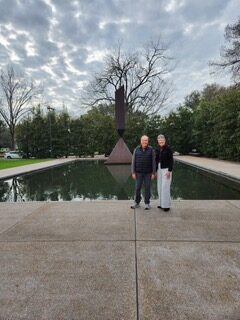By Marian McClure Taylor
“I left Philadelphia to work here when racial injustice was so blatant in the national news during the pandemic. I wanted somehow to be on the right side. Landing work here was a God thing.”
This was the personal testimony of our African-American guide when a colleague and I visited the Rothko Chapel in Houston on January 26. The visit came at the end of a reunion I attended. It was a gathering of former executives from state-level councils of churches and interfaith alliances. There are 34 state-wide organizations in the US that work to promote fellowship and unity among diverse Christians, often including a shared voice on public affairs. In the Synod of Living Waters, Kentucky is the only state with such an organization. The Kentucky Council of Churches (www.kycouncilofchurches.org) was organized in 1947, and I had the privilege of leading it from 2009 – 2015.
What our guide at the Rothko Chapel said about how a life change can be a “God thing” resonated with the experiences shared during the reunion of state ecumenical executives. My former colleagues and I told of having left employment with a council of churches and having embraced new commitments. Some of us remain involved in ecumenism, and all are still actively seeking justice and peace.
For instance, one is building a “co-living” apartment complex. Another maintains strong relations with Palestinian Christians. One works on the needs of rural Americans and another chairs her presbytery’s trustees. One is on the board of an organ and tissue donation charity, another is doing campus ministry, almost everyone is caring for relatives, and several are preaching every Sunday. Yet another participant (yours truly!) is standing for moderator of the PCUSA General Assembly, because I want to encourage the work being done by Presbyterians and our global partners as we share God’s liberating love through word and deed, especially truth-and-reconciliation work.

One of our participants, David Leslie, left Ecumenical Ministries of Oregon to become the director of the Rothko Chapel (www.rothkochapel.org). With his help, the Rev. Jan Flaaten of Arizona and I easily made an appointment to visit there on our way to the airport.
The paintings at the Rothko chapel were created by the artist, Mark Rothko. I wasn’t expecting them to be huge panels of mostly black paint. After my eyes adjusted to the light, I could see variations in the surfaces and degrees of darkness of each panel, and I began imagining what was there. Jan commented that we humans do that imaginative work whenever we encounter a void. Perhaps that’s a way we demonstrate that we are created in the image of God. The void of retirement or of new employment is no exception – it is a moment for renewed imagination and creativity!
